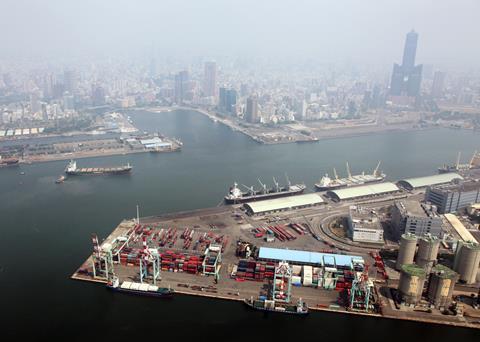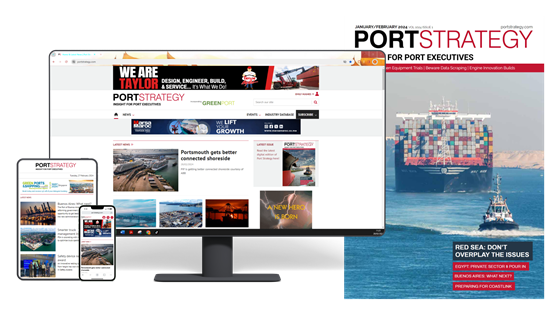The port sector and shipping industry are not immune from the spotlight of media attention, focus for legislation and scrutiny by local communities, particularly when it comes to considerations of environmental management, writes Dr Christopher Wooldridge, academic associate, Cardiff University, UK.

“Then you better start swimmin’ or you’ll sink like a stone.
Fifty years on from the release of the iconic song that challenged the attitude of governments to society and change, the options for reconciling the often conflicting expectations of stakeholders with decision-makers remains as topical and as controversial as ever.
Then and now
Back in the mid-1960s, environmental concerns focused on the impacts of wind, waves, tide and currents as they influenced the day-to-day operations of port activities and shipping operations. Environmental considerations were restricted to selected areas of preservation of landscape and wildlife. By the same token, environmental considerations by port authorities were largely restricted to the quay-side alone.
In Europe, benchmark events and projects such as the Environmental Challenge for Port Authorities (ECEPA, 1993), the European Sea Ports Organization’s (ESPO) Environmental Code of Practice (1994), Eco-information (1997), EcoPorts (2002) and the ESPO Green Guide (2012) all contributed to the development and implementation of the sector’s environmental policy of compliance through voluntary, self-regulation and the ambition of a ‘level playing-field’ in terms of enforcement. Similarly, the American Association of Port Authorities’ (www.aapa-ports.org) Environmental Management Handbook (1998) provided guidance on the varying degrees of control that port authorities may have over operations at their facilities.
Nowadays, the definition and scope of environmental management itself has evolved from the act of pure conservation and protection of habitats, ecosystems and natural resources, to also include the objective of sustainable development measured in terms of economic costs, benefits and overall efficiencies.
The area over which functional control or influence by the port authority may reasonably be expected to be applied has expanded dramatically in order to take into account the management of impacts throughout the port area, significant zones of cities and increasingly, into the control of the impacts of the logistic chain itself.
Traditionally, the main driver for the implementation and operation of an effective port Environmental Management System (EMS) was that of compliance with legislation and regulation (and it may be argued that these provisions, of course, remain non-negotiable). Increasingly, however, considerations of cost and risk reduction and the overall goal of sustainability act as catalysts for enhanced environmental performance.
Today, EMS requires a far more comprehensive and integrated approach as environmental issues must be also be addressed in the context of safety, health, security and the plethora of stakeholder claims at a scale that varies from local to global. As a consequence, ports are under increasing pressure to demonstrate performance and a networked approach is being developed for the European sector (eg www.portopia.eu).
The global reach of EcoPorts
The port sector has an established track record of pro-active, collaborative programmes of activity that have delivered established environmental policies, tools and methodologies for the actual implementation of effective EMS. Within ESPO, EcoPorts is the network of ports sharing environmental experience and implementing best environmental practice through time and cost effective options.
The goal is to eliminate the environment as a competitive factor between ports and to avoid reinventing the wheel in terms of developing practicable solutions to environmental problems. A benefit of the phased approach to EMS using the EcoPorts approach is that it includes the voluntary option of certification to the sector’s own international standard of EMS, the Port Environmental Review System (PERS) that is independently audited by Lloyd’s Register.
Recognising that the port sector is the epitome of a global network, ports outside Europe are able to collaborate in the EcoPorts tools and certification process through Eco-Sustainable Logistic Chain (www.ecoslc.eu), where as well as training in the Ecoports tools and certification in the EMS standard, assistance in a systems approach for developing a harmonised approach to sustainable operations of ports and logistics through collaboration.
The first port outside Europe to achieve the PERS certification for its standard of EMS was the Port of Santa Marta in Colombia, where the objectives and targets of its publicly available environmental policy statement are witnessed by its achievement of ISO 14001 and PERS.
More recently, the Port of Kaohsiung in Taiwan was awarded PERS certification and the Port of Taichung and the Port of Keelung are currently in the process of certification. Kaohsiung's EcoPorts certification demonstrates a successful model of coordination between Government (Ministry of Transportation and Communication, MOTC), Port Management Authority (Taiwan International Ports Corporation, TIPC) and University (National Sun Yat-sen University, NSYSU).
Based on the green port policy in Taiwan, the Harbor and Marine Technology Center under MOTC initiated a four-year research project called Research of Taiwan Green Port Establishment in 2011. This funded research project was implemented by NSYSU. One of the main objectives of the project was to build-up a green port framework in Taiwan which conforms to international regulations. In 2013, NSYSU began to assist TIPC Kaohsiung branch in SDM evaluation and finished the PERS and achieved EcoPorts certification in October 2014.
Lu, Shiau-Yun, professor at NSYSU, says: “This certification demonstrates the efficiency of the green port execution, both in the aspects of policy making and implementation. As demonstrated elsewhere within the Ecoports network, the collaboration between industry and academia can be a particularly efficient partnership in the application of the tools and methodologies."
Diagram 1 illustrates the relationship between government, port management authority and university in delivering an efficient and powerful coordination model for green port policy in Taiwan.
Based on the EcoPorts' database, it is possible to identify the top ten environmental issues for the sector as reported by port authorities in their responses to the Self-Diagnosis Methodology (SDM). Currently, the list is:
1. Air quality
2. Port garbage/waste
3. Energy consumption
4. Noise
5. Ship waste
6. Local community
7. Dredging operations
8. Dust
9. Water quality
10. Port development (land)
Effective control of these issues requires the operation of a credible standard of EMS. However, the aspects and their associated challenges may change with time, so an EMS that is regularly reviewed will assist a port authority in managing its own liabilities and responsibilities.
Looking to the future
The port sector is poised to consider a new raft of issues under ever-changing circumstances in terms of the economic, political and natural climate. For example, the Sustainable Development Technical Committee of ESPO identifies topics such as the directive on the deployment of alternative fuels infrastructure, including LNG terminals, shore-side electricity supply, the Sulphur Directive, the Water Framework Directive, and differentiated port dues as requiring particular consideration, along with an up-dated version of the Green guide.
The whole debate as to the extent to which port authorities may reasonably be expected to bring influence to bear on the environmental performance of its tenants and operators (including shipping) is set to expand.
“Environmental issues are not only the concern of port authorities and shipping companies but must also involve all the stakeholders. Ports are keen to be seen as ambassadors of good practice”, says Ellen Kaasik, Chair, Sustainable Development Technical Committee, ESPO.
Where it may reasonably be argued that the integration of port and shipping environmental management brings mutual advantage to the sector, industry and society as a whole, the question of who carries the cost of ‘green shipping’ is still a subject of debate.
“There are several key questions that will need to be answered related to the concept of reward beyond compliance, how costs are recovered and the components that are factored-in to such schemes,” says Antonis Michail, senior advisor, ESPO.
The debate will continue as to who pays? The polluter, the tax-payer, or end-user?
At the same time, there are likely to be continued, substantial changes in ports in terms of ownership, scale, finance and organisation. “Management systems will need to adapt as the demand for environmental protection, prevention rather than cure and sustainable development continue to be made. The most pro-active ports will include environment and sustainability in their business plans where changes are again occurring reflecting private sector and commercial financing initiatives”, says Herman Journée, director, EcoSLC.
The roles of ports are already being redefined and it can be expected that ports will widen their orientation and scope and thus require new strategies, policies and operational measures. Port authorities and sector organisations will increasingly need to set their environmental objectives within the realm of hinterland, regional, or even national and global considerations.
These will need to be mindful of the different approaches required as they endeavour to navigate their course through the challenging seas of legislation, the commercial imperative and society’s expectations – “For the times they are a-changin”.
Chris Wooldridge will be presenting and moderating at the forthcoming GreenPort Congress.
Book your place now! Delegate packages covering both the GreenPort Congress and GreenPort Cruise Conference are available. Save more with preferential rates for delegate packages covering both the GreenPort Congress and GreenPort Cruise Conference.
For more information regarding GreenPort Cruise and/or Greenport Congress 2015, please contact the Events team on +44 1329 825335 or email congress@greenport.com.







